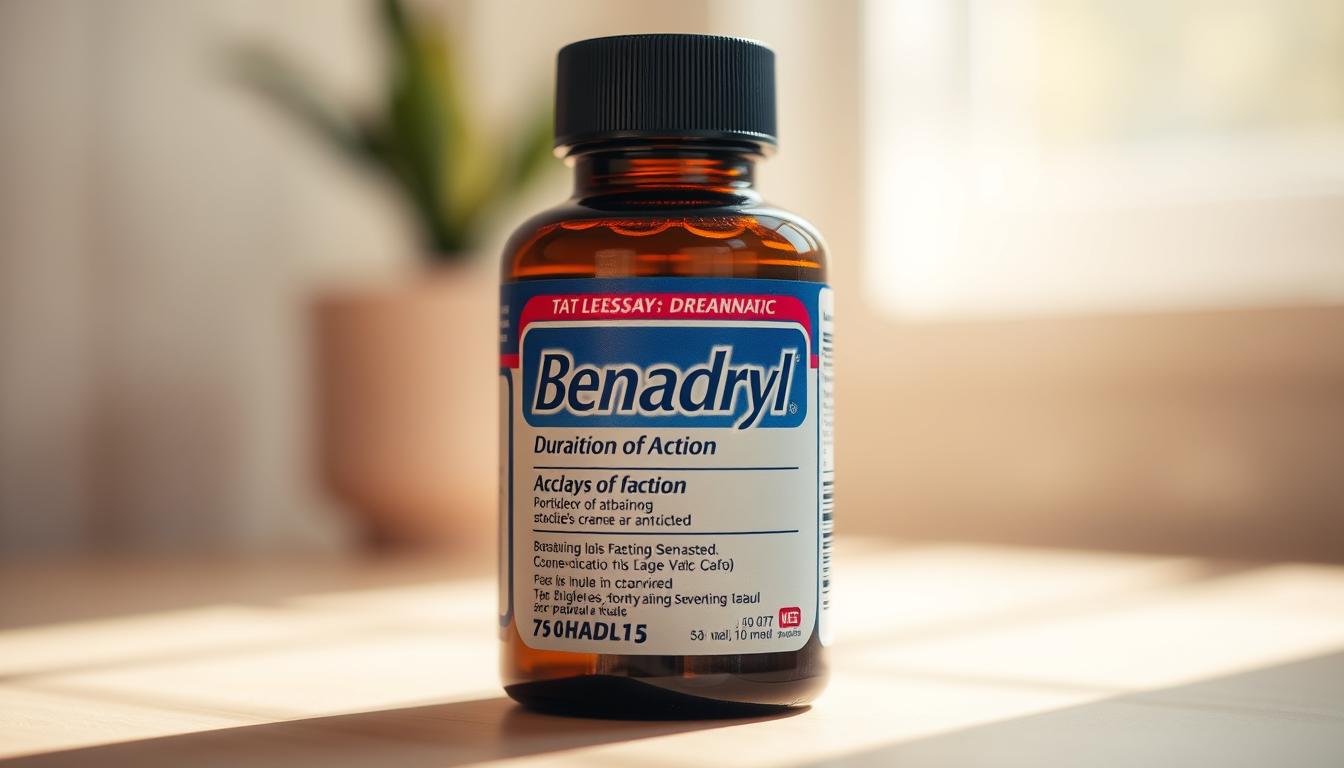Knowing how long Benadryl lasts is key for allergy sufferers. This antihistamine works differently on everyone, with its effects lasting varying lengths of time. Whether you’re fighting seasonal allergies or sudden allergic reactions, knowing when Benadryl’s effects fade can help you plan your day and avoid side effects.
Benadryl starts working fast, but how long it lasts can be tricky. Most people feel its main effects for 4-6 hours. But, drowsiness might stick around longer. How fast Benadryl wears off depends on your metabolism, how much you take, and your health.
Many people want to know how long Benadryl lasts to use it safely. Your age, weight, and health can change how fast your body breaks down the drug. Doctors say it’s important to know these differences to avoid bad reactions or side effects.
Key Takeaways
- Benadryl typically remains active for 4-6 hours
- Individual metabolism significantly affects wear-off time
- Drowsiness can persist longer than primary medication effects
- Body weight and age impact drug processing
- Consulting a healthcare provider is recommended for personalized guidance
Understanding Benadryl and Its Active Ingredients
Benadryl is a strong antihistamine that fights allergy symptoms well. We explore its science and how it helps.
At its core, Benadryl has diphenhydramine HCl. This powerful part blocks histamine receptors in the body. It’s what makes Benadryl good at handling allergic reactions.
The Role of Diphenhydramine HCl
Diphenhydramine HCl works fast to lessen allergy symptoms by:
- Stopping histamine production
- Lessening inflammation
- Reducing itching and swelling
- Offering quick relief
Common Forms and Dosages
Benadryl is available in various forms to meet different needs:
| Form | Typical Dosage | Best For |
|---|---|---|
| Tablets | 25-50 mg every 4-6 hours | Adults and children over 12 |
| Liquid | 12.5-25 mg per dose | Children and those who struggle swallowing pills |
| Topical Cream | Apply as needed | Localized skin allergies |
How Antihistamines Work in Your Body
Antihistamines like Benadryl stop the body’s allergic reaction. When allergens cause histamine release, diphenhydramine HCl blocks these signals. This reduces symptoms like sneezing, itching, and swelling.
Knowing how Benadryl works helps you manage allergies better. It ensures you get relief when you need it most.
The Average Duration of Benadryl Effects
Knowing how long Benadryl lasts is key for those fighting allergies. Most people feel Benadryl’s effects in 15-30 minutes. The best results usually come 1-2 hours later.
Benadryl’s effects last about 4-6 hours, but this can change based on many factors. How our bodies process the drug varies, making each person’s experience unique.
- Onset of action: 15-30 minutes
- Peak effectiveness: 1-2 hours
- Total active duration: 4-6 hours
- Sedative effects: Can last up to 8 hours
Several things can affect how long Benadryl lasts:
- How fast your body breaks it down
- Your weight
- How old you are
- Your overall health
| Dosage Form | Average Duration | Typical Use |
|---|---|---|
| Oral Tablets | 4-6 hours | Allergy relief |
| Liquid Gel Caps | 4-5 hours | Faster absorption |
| Liquid Formulation | 3-4 hours | Quick relief |
Keep in mind, everyone’s experience is different. Always talk to a doctor for advice that fits you.
Factors That Influence How Long Benadryl Stays in Your System
Understanding how Benadryl is metabolized involves looking at several key factors. These factors affect how fast the drug is processed in your body. Just like everyone’s wellness journey is unique, so is how quickly Benadryl is cleared from the body.
Our bodies are complex, with many variables affecting how we process medications. The time it takes for Benadryl to clear from your system can vary a lot. This is because everyone’s body is different.
Age and Metabolism Dynamics
How fast your body metabolizes Benadryl is important. Here are some points to consider:
- Younger adults tend to have faster metabolism rates
- Older people may have slower Benadryl processing
- How fast your metabolism is affects how quickly the drug is cleared
Body Weight and Composition Impact
Your body’s composition affects how Benadryl interacts with you. Consider these factors:
- Being heavier can slow down how fast Benadryl is metabolized
- The ratio of muscle to fat affects how the drug is distributed
- Everyone’s body chemistry is different, impacting how the drug works
Liver and Kidney Function
These organs are key in processing medications like Benadryl. Their health determines how fast the drug is removed:
- A healthy liver helps speed up drug metabolism
- Kidney health also affects how quickly the drug is cleared
- Problems with these organs can make Benadryl stay in your system longer
Pro tip: Always talk to healthcare professionals to understand your specific Benadryl metabolism rate and any individual variations.
How Long Does It Take for Benadryl to Wear Off?
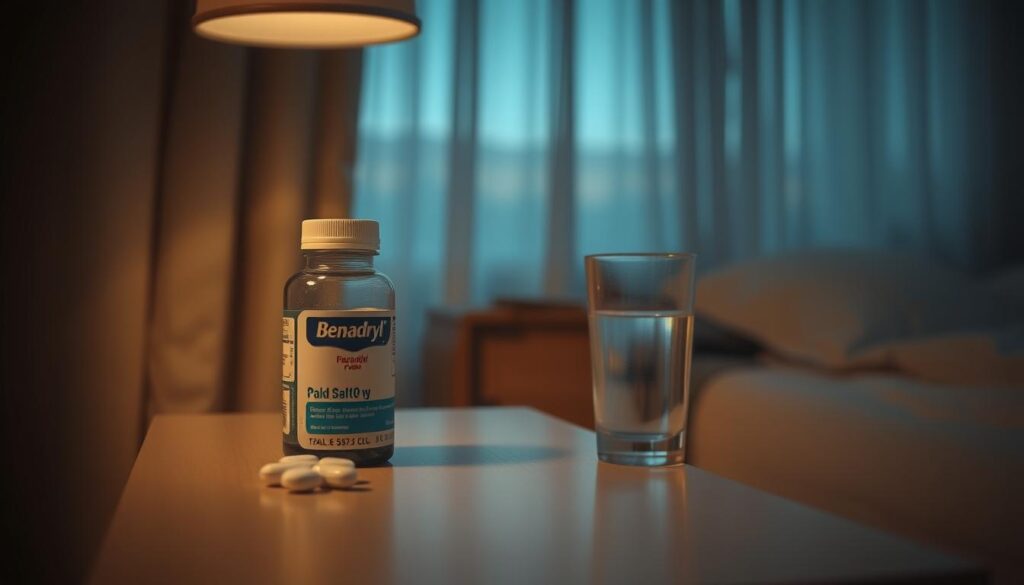
Knowing how long Benadryl lasts is key to using it right. The time it takes for Benadryl to wear off can vary. But, most people start to feel its effects lessen in 4-6 hours.
When thinking about how long Benadryl lasts, remember its special traits:
- Its strongest effects happen in 1-2 hours
- Drowsiness fades after 4-6 hours
- It can take up to 24 hours to fully leave your body
Your body’s metabolism affects how fast Benadryl wears off. Things like age, weight, and health matter. Younger people might feel its effects less quickly than older ones.
Pro tip: If you’re worried about how long it lasts, talk to a doctor. They can give advice based on your health.
For most, Benadryl’s sleepy effects will fade, letting you get back to your day. But, wait until you’re fully awake before driving or using big machines.
Benadryl’s Half-Life and Elimination Process
Knowing how Benadryl works in your body helps you use it better. The half-life of Benadryl is key to understanding how long it stays active.
After taking Benadryl, it starts its journey through your body. The time it takes to leave your system varies. Let’s look at what affects this process.
Decoding Drug Half-Life
Drug half-life is the time it takes for half of the drug to leave your blood. For Benadryl, this is usually:
- Average half-life of 2-8 hours
- Peak concentration reached within 1-4 hours
- Complete elimination can take up to 24 hours
Complete Elimination Timeline
Our bodies break down Benadryl through a specific process. The time it takes to get rid of it depends on several factors. These include age, metabolism, and health.
| Time Frame | Elimination Stage | Percentage Removed |
|---|---|---|
| 2-4 Hours | Initial Metabolism | 25-50% |
| 4-8 Hours | Continued Breakdown | 50-75% |
| 8-24 Hours | Final Elimination | 75-100% |
Things like liver function, how well you drink water, and your metabolism can change how fast Benadryl is eliminated. Always talk to a doctor for advice that fits you.
Common Side Effects and Their Duration
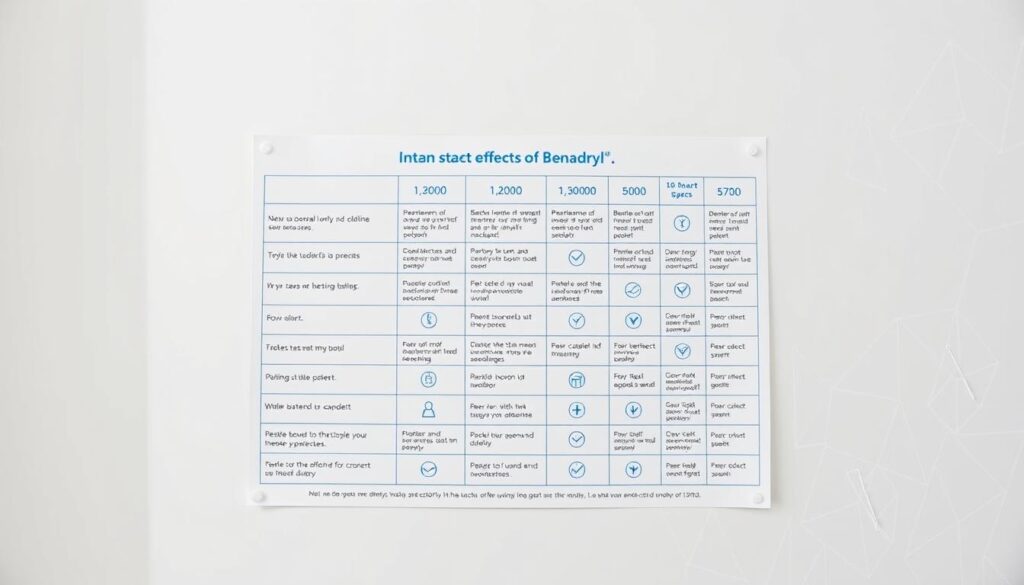
It’s important to know how long Benadryl’s side effects last. Diphenhydramine can cause different reactions. These can vary in how strong they are and how long they last.
Common side effects of Benadryl include:
- Drowsiness
- Dry mouth
- Blurred vision
- Constipation
- Dizziness
These side effects usually last 4-6 hours after taking Benadryl. How long they last can vary from person to person, depending on how fast you metabolize it and the dose you take.
| Side Effect | Typical Duration | Intensity |
|---|---|---|
| Drowsiness | 4-6 hours | High |
| Dry Mouth | 2-4 hours | Moderate |
| Dizziness | 3-5 hours | Moderate |
| Blurred Vision | 2-3 hours | Low |
Watching how your body reacts to Benadryl’s side effects is key. If you’re uncomfortable, talk to a healthcare professional. They can help if the side effects don’t go away or get worse.
Drowsiness and Sedation: Timeline for Recovery
Benadryl can affect your daily life, mainly because of drowsiness. Knowing how it makes you feel alert is key to using it safely and right.
Benadryl’s biggest side effect is drowsiness. Its sedative effect hits you hard within 1-2 hours and can last for hours. This means you might struggle with complex tasks during this time.
Managing Daytime Sleepiness
To handle Benadryl’s drowsiness, try these tips:
- Take the medication when you have time to rest
- Avoid driving or operating heavy machinery
- Plan for reduced physical and mental activity
- Stay hydrated and maintain a consistent sleep schedule
Safe Activities While Under Effects
While feeling the sedative effects of Benadryl, do low-energy activities like:
- Reading a book
- Watching light entertainment
- Relaxing at home
- Listening to calm music
Keep in mind, how Benadryl affects you can differ. Some people might feel more drowsy than others. This depends on your metabolism, age, and health.
Signs That Benadryl Is Wearing Off
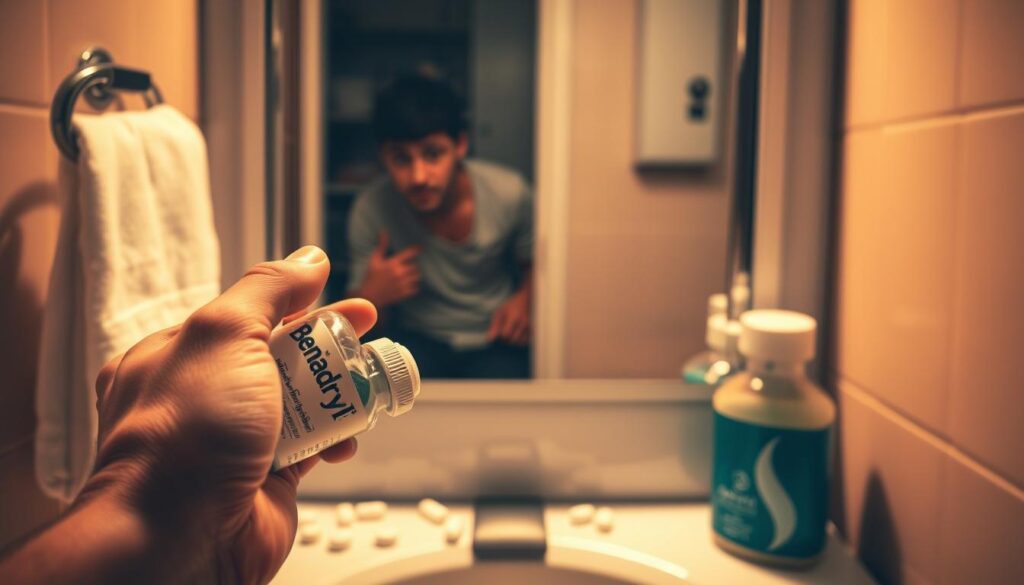
Knowing when Benadryl is wearing off is key to managing your meds well. As the benadryl withdrawal time nears, your body will show signs that the drug’s effects are fading.
Signs that Benadryl is wearing off include:
- Gradual return of alertness – The intense drowsiness starts to fade
- Reemergence of original allergy symptoms
- Decreased sedation effects
- Normalization of mental clarity
During the benadryl withdrawal time, you might notice small changes in your body’s response. These signs usually show up 4-6 hours after taking the drug. Look out for:
- Increased energy levels
- Reduced medication-induced sleepiness
- Potential return of mild allergic reactions
How you react to benadryl withdrawal time can vary. It depends on your metabolism, dosage, and health. Listen to how your body reacts and talk to a doctor if you notice anything odd.
Keeping an eye on these signs helps you know when the drug’s effects are fading. This way, you can decide if you need another dose or a different treatment plan.
When to Expect Complete Clearance from Your System
Knowing how long Benadryl stays in your system is key to using it right. How fast Benadryl leaves your body can change a lot. It depends on many things about you.
For most people, Benadryl leaves the body in 24 to 48 hours. Several things affect how fast it goes:
- Metabolism rate
- Age
- Body weight
- Overall health condition
Detection Windows in Different Tests
Medical tests can find Benadryl for different times. Here’s when you might test positive:
| Test Type | Detection Window |
|---|---|
| Blood Test | 24-48 hours |
| Urine Test | 2-4 days |
| Hair Follicle Test | Up to 90 days |
Residual Effects Timeline
After Benadryl is mostly gone, some effects might stay. Most people see these effects fade over 24-36 hours. Your liver and kidneys work to get rid of it slowly.
- First 12 hours: Peak effects start to go down
- 24-36 hours: Drug levels drop a lot
- 48 hours: Most of it is gone
Everyone is different. Always talk to a doctor about how Benadryl affects you.
Safety Considerations and Timing Between Doses
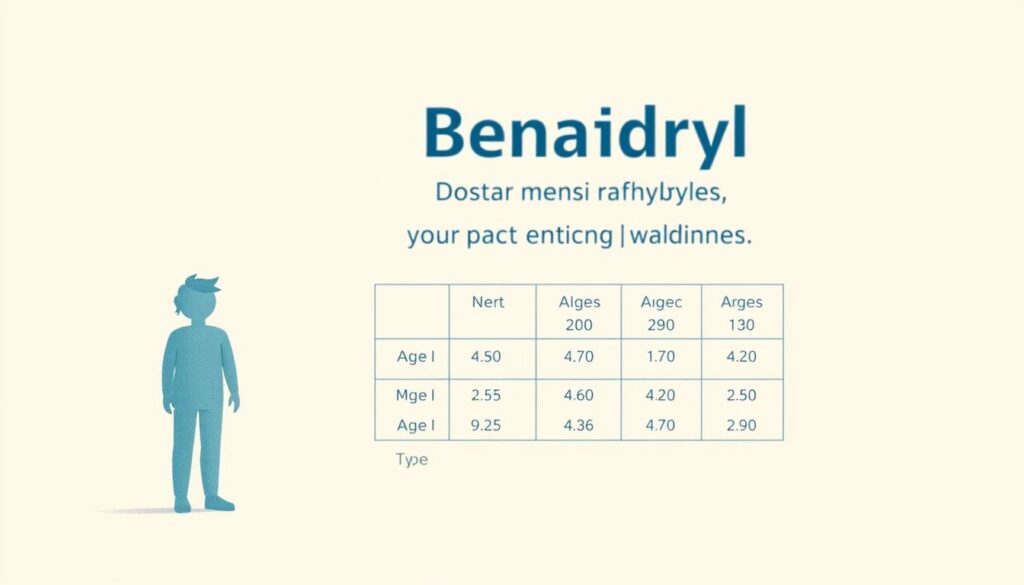
It’s important to know how to use Benadryl safely to manage allergies. The time it takes for Benadryl to wear off affects when you can take more. Our guidelines will help you understand the right timing and dosage for safety.
When thinking about how long Benadryl lasts, it’s key to follow the dosage instructions. For adults, the usual dose is:
- Maximum of 4 doses per 24-hour period
- Minimum 4-6 hours between doses
- Do not exceed recommended daily limits
It’s also important to watch how your body reacts and any interactions with other drugs. People with certain health issues should talk to a doctor before taking it.
| Age Group | Recommended Dosage | Maximum Daily Doses |
|---|---|---|
| Adults | 1-2 tablets (25-50mg) | 4 doses |
| Children (6-12) | 1 tablet (12.5mg) | 2 doses |
Warning: Always read labels carefully and never exceed recommended dosages. The time Benadryl lasts can change based on your body’s metabolism, weight, and health.
Keeping track of how you feel and react to the medication is vital. If symptoms don’t go away or if you have bad side effects, call your doctor right away.
Special Populations and Extended Wear-Off Times
Benadryl’s effects can vary across different age groups. It’s important to understand how it works with each group’s unique body. This ensures safe and effective use for all.
The way Benadryl is broken down in the body changes with age and health. Some groups may feel its effects longer than others.
Elderly Patients: Slower Processing
Older adults metabolize drugs slower because of less liver and kidney function. This means Benadryl stays in their system longer. It can lead to longer-lasting effects.
- Slower metabolic processes
- Increased sensitivity to medication
- Potential for extended drowsiness
Children and Teenagers: Unique Considerations
Younger people process drugs differently. Their bodies react uniquely to antihistamines. This affects how long Benadryl lasts.
| Age Group | Metabolism Rate | Typical Duration |
|---|---|---|
| Children (2-12) | Faster | 4-6 hours |
| Teenagers (13-19) | Moderate | 6-8 hours |
Always talk to healthcare professionals for advice on medication. Everyone’s body reacts differently.
Interactions That May Extend Benadryl’s Effects
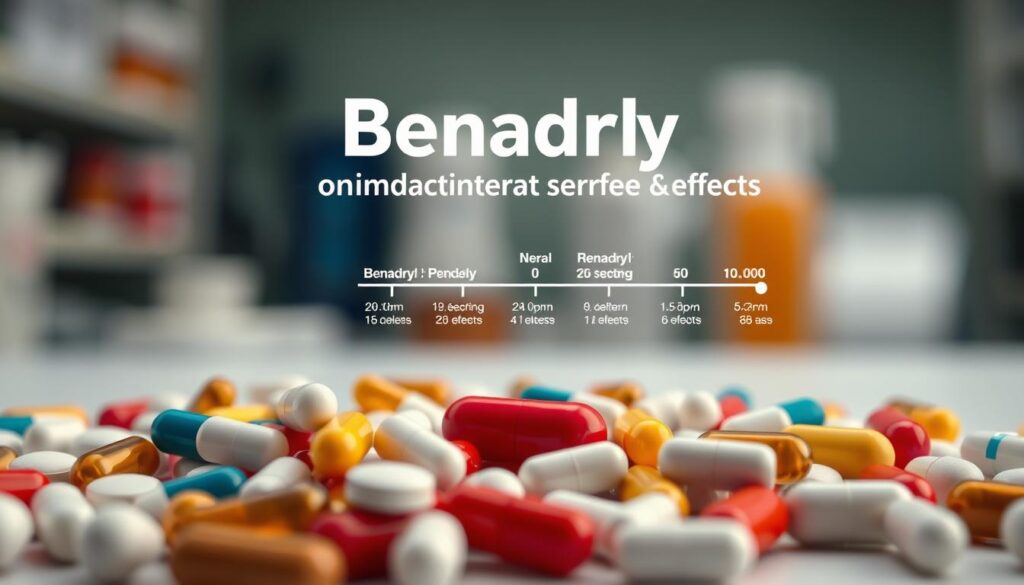
It’s important to know about possible interactions when using Benadryl. Some things can make Benadryl last longer than usual in your body. This can change how long it stays active.
Many drugs and substances can affect Benadryl. This can lead to complex reactions:
- Central nervous system depressants
- Sedative medications
- Alcohol consumption
- Certain antidepressants
Some drugs can make Benadryl last longer. Medications like tranquilizers, muscle relaxants, and sleep aids may intensify diphenhydramine’s sedative properties. This can make you sleepier and less alert.
How your body breaks down Benadryl matters too. People with slower metabolisms or liver issues might feel Benadryl’s effects longer. This is because their bodies process it slower.
Drinking alcohol with Benadryl is risky. It can make you very sleepy and slow down your thinking. This can make Benadryl last even longer in your system.
- Avoid mixing Benadryl with prescription sedatives
- Consult healthcare professionals about possible interactions
- Watch how your body reacts to different medications
Always talk to your doctor about all the medicines you’re taking. This helps them know if any might affect Benadryl’s how long it lasts and how well it works.
Alternative Antihistamines with Different Duration Profiles
Looking for alternatives to Benadryl? Knowing the benadryl half-life is key. Different meds have unique durations that fit individual needs.
Let’s explore some popular choices with varied benadryl effects duration:
- Zyrtec (Cetirizine): Lasts 24 hours with little sleepiness
- Claritin (Loratadine): A non-drowsy option for long relief
- Allegra (Fexofenadine): Acts fast with few side effects
Each antihistamine has its own strengths for fighting allergies. Zyrtec lasts longer, while Allegra works quickly without making you sleepy.
| Antihistamine | Duration | Sedation Level |
|---|---|---|
| Benadryl | 4-6 hours | High |
| Zyrtec | 24 hours | Low |
| Allegra | 12-24 hours | Minimal |
Talking to a healthcare pro can help pick the best antihistamine for you. They consider your allergy symptoms and lifestyle.
Managing the Transition as Benadryl Wears Off
When Benadryl’s effects fade, it’s important to watch your body’s needs. Knowing how long Benadryl lasts helps you manage allergies better.
As Benadryl’s effects fade, your allergies might come back. It’s key to get ready for this to stay comfortable and control symptoms.
Recognizing Symptom Resurgence
Look out for these signs as Benadryl’s effects wear off:
- Itching starts again
- Nasal congestion comes back
- Allergic reactions get worse
- You become more sensitive to allergens
Strategic Medication Switching
To handle Benadryl’s fading, try these options:
- Talk to your doctor about long-acting antihistamines
- Look into non-drowsy allergy meds
- Consider using more than one treatment
- Try to prevent allergies from starting
Pro tip: Always talk to a healthcare professional before switching medications. This ensures safe and effective allergy care.
By understanding your body’s needs and planning, you can smoothly switch between treatments. This way, you avoid uncomfortable gaps in symptom relief.
Conclusion
Knowing how long Benadryl lasts is key to using it safely and right. We’ve looked into how it works in your body, from start to finish. This knowledge helps you make smart choices about your health and meds.
Our guide made tough medical info easy to get. We talked about how fast it’s broken down and possible side effects. This way, you can use Benadryl with confidence. It’s all about listening to your body and knowing how it reacts.
Your health path is unique, and managing meds is important. Benadryl can help with allergies, but always talk to a doctor first. Everyone reacts differently to meds, so expert advice is a big help.
Keep yourself informed and safe, just like you do with other parts of your life. Knowing about Benadryl lets you make choices that are best for you.

